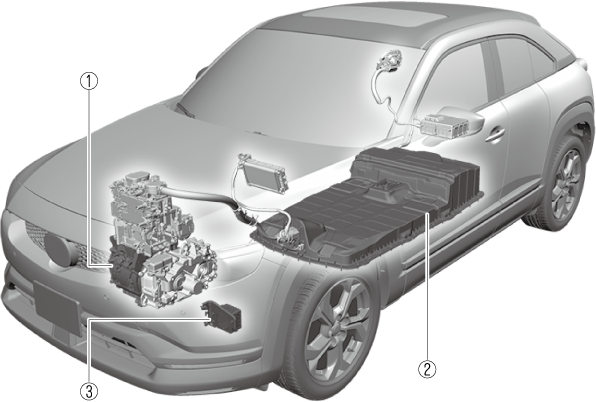e-SKYACTIV EV
e-SKYACTIV EV
The e-SKYACTIV EV is driven by motor power using the electrical power stored in the high voltage battery. This vehicle is an eco-friendly vehicle which emits no exhaust gas because fuel is not used.

-
Motor, Regenerative braking
-
High voltage battery
-
Approaching vehicle audible system
Motor
The motor transmits the motor power to the wheels using the electrical power of the high voltage battery.
Regenerative energy and regenerative braking
The motor functions as a generator to recover energy by charging the high voltage battery (regenerative energy). In the following cases, the braking force of the vehicle can be obtained using the resistance force of the motor generated when energy is recovered (regenerative braking).
-
The accelerator pedal is released.
-
The brake pedal is depressed.
High voltage battery
The high voltage battery is a large-capacity battery and stores the charged power and the electrical power generated by regenerative braking.
Approaching vehicle audible system
The approaching vehicle audible system notifies pedestrians of the vehicle approaching using a warning sound while driving at low speeds.
Refer to Approaching Vehicle Audible System (Search).
Maintenance and Repairs
For vehicle maintenance or repairs, consult an Authorized Mazda Dealer.
Technical knowledge and skill are necessary in handling the high voltage battery.
To ensure safe and correct handling of the high voltage battery, always heed the following precautions:
-
Do not remove the high voltage battery.
-
Do not resell, transfer, or modify the high voltage battery.
-
Do not use the battery on vehicles other than those equipped with the high voltage battery.
If the high voltage battery is not handled properly, the following may occur which could lead to serious injury or death:
-
Touching an unattended high voltage battery may cause an electrical shock accident.
-
If the high voltage battery is used on a vehicle other than one equipped (including modified vehicles) with a high voltage battery, an electrical shock accident, heat generation, smoking, combustion, and explosions, or an electrolyte leakage may occur.
Heed the following instructions to prevent deterioration of the high voltage battery or damage to the high voltage battery.
-
Do not leave the vehicle for a long time under extremely high or low temperature conditions.
-
Do not leave the vehicle for 14 days or longer while the high voltage battery is at 0 (zero) charge.
The high voltage battery has a certain battery life. The battery life differs depending on how the vehicle is used and the driving conditions.
Scrapping Your Vehicle and Disposing of the High Voltage Battery
Accident Occurs
If the vehicle receives an impact of a certain level or greater in a collision, the EV system stops. In this case, the EV system malfunction warning indication/warning light displays/turns on and the EV system may not start. Contact an Authorized Mazda Dealer immediately.
Never touch electrical wiring that may be protruding into or outside of the cabin:
Otherwise, it could result in electrical shock and serious injury.
Never touch any area where electrolyte is visible or electrolyte is leaking from the area:
If any electrolyte from the high voltage battery gets in the eyes or on the skin, it could cause loss of vision or skin reactions. If this happens, immediately flush your eyes with water for 15 minutes or wash your skin with soap thoroughly and get medical attention.
Never approach objects that are on fire or extremely hot:
Electrolyte in the high voltage battery may cause a fire.
If the vehicle catches fire, extinguish the fire using a fire extinguisher (type ABC, BC, or C).
Only extinguish a fire with water when a large amount of water is available such as from a fire hydrant. Otherwise, it could lead to an accident.
Steering Wheel Paddle
The steering wheel paddle is a function that makes it easy to adjust the vehicle speed according to the accelerator pedal operation.
Acceleration/deceleration is possible according to the various driving conditions such as on an up or down slope, during traffic jams, or high-speed driving.
Avoid using the steering wheel paddles when driving on wet roads, snow-covered roads, or icy roads:
Otherwise, the tires will slip which could lead to an accident.
Setting
By operating the plus switch (+/OFF), the deceleration force is decreased when releasing the accelerator pedal, and the vehicle accelerates quickly when depressing the accelerator pedal.

-
Plus switch (+/OFF)
By operating the minus switch (–), the deceleration force is increased when releasing the accelerator pedal, and the vehicle accelerates slowly when depressing the accelerator pedal.

-
Minus switch (–)
-
When the cruise control and the Mazda Radar Cruise Control with Stop & Go function (MRCC with Stop & Go function), or the Traffic Jam Assist (TJA) is operating, the steering wheel paddle setting cannot be changed.
-
When performing the following operations, the steering wheel paddle returns to the default setting.
-
Plus switch (+/OFF) is kept pulled for a certain period of time
-
Selector lever is shifted to any position from D
-
Power switch is switched OFF
-
Indication
The operation condition of the steering wheel paddle is displayed on the multi-information display.

-
Steering wheel paddle display
|
Indication |
Switch operation |
Deceleration force |
Acceleration force |
|
|---|---|---|---|---|
|
Plus switch (+/OFF) |
Minus switch (–) |
|||
 |
- |
 |
Weak |
Quickly |
 |
 |
 |
Slightly weak |
Slightly quick |
 |
 |
 |
Normal |
Normal |
 |
 |
 |
Slightly strong |
Slightly slow |
 |
 |
- |
Strong |
Slowly |
Particular driving situation

-
Driving on a downward slope or during traffic jams
-
Driving on an upward slope or expressways
-
If the high voltage battery level is high or the high voltage battery temperature is low, there may be a small change in the deceleration force or no change at all.
-
The brake lights may turn on when the deceleration force is strong.




